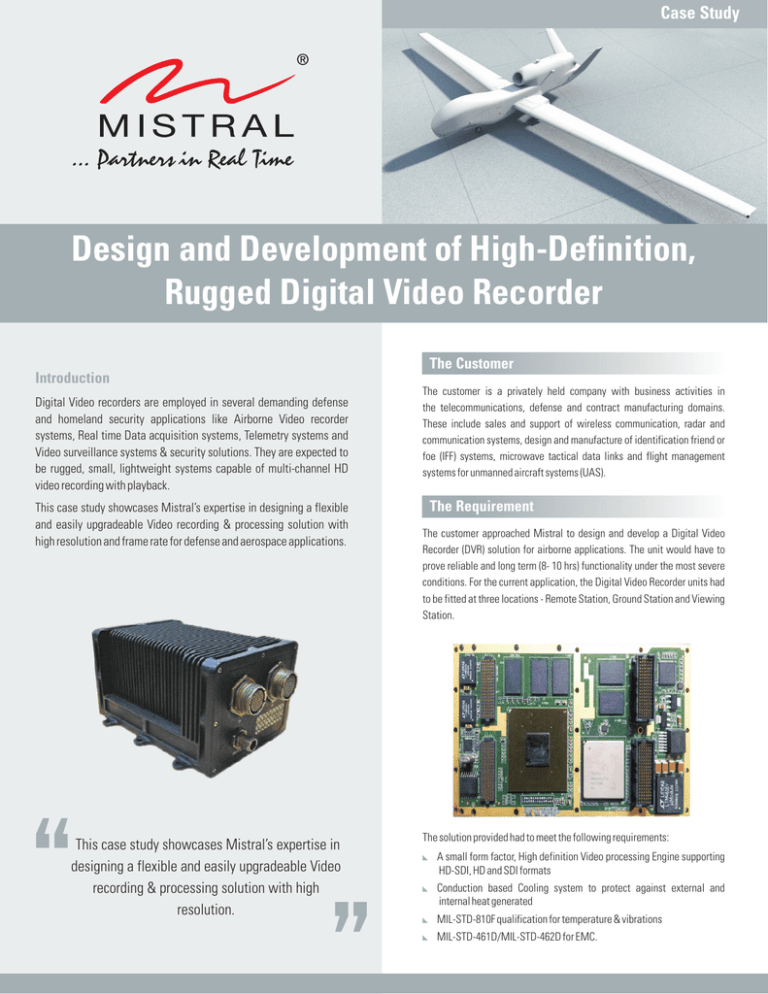
Case Study
Design and Development of High-Definition,
Rugged Digital Video Recorder
Introduction
Digital Video recorders are employed in several demanding defense
and homeland security applications like Airborne Video recorder
systems, Real time Data acquisition systems, Telemetry systems and
Video surveillance systems & security solutions. They are expected to
be rugged, small, lightweight systems capable of multi-channel HD
video recording with playback.
This case study showcases Mistral’s expertise in designing a flexible
and easily upgradeable Video recording & processing solution with
high resolution and frame rate for defense and aerospace applications.
This case study showcases Mistral’s expertise in
designing a flexible and easily upgradeable Video
recording & processing solution with high
resolution.
The Customer
The customer is a privately held company with business activities in
the telecommunications, defense and contract manufacturing domains.
These include sales and support of wireless communication, radar and
communication systems, design and manufacture of identification friend or
foe (IFF) systems, microwave tactical data links and flight management
systems for unmanned aircraft systems (UAS).
The Requirement
The customer approached Mistral to design and develop a Digital Video
Recorder (DVR) solution for airborne applications. The unit would have to
prove reliable and long term (8- 10 hrs) functionality under the most severe
conditions. For the current application, the Digital Video Recorder units had
to be fitted at three locations - Remote Station, Ground Station and Viewing
Station.
The solution provided had to meet the following requirements:
:
A small form factor, High definition Video processing Engine supporting
HD-SDI, HD and SDI formats
:
Conduction based Cooling system to protect against external and
internal heat generated
:
MIL-STD-810F qualification for temperature & vibrations
:
MIL-STD-461D/MIL-STD-462D for EMC.
The DVR unit mounted on the UAV (remote station) was expected to capture and
encode multiple UAV cameras inputs (HD-SDI, HDI, SDI). The encoded data had
to be converted to Analog signals before being transmitted to the ground
station. The DVR unit in the ground station had to decode the received signal to
display for immediate viewing. The same data had to be also sent via Ethernet
to the Viewing station where the captured data would be studied in detail and
stored for future reference.
The DVR had to perform Encode, Decode and Transcode operations for the
following video compression formats: H.264, MPEG2, MPEG4 SP/ASP in 1080p
video resolution
Solution Provided
To meet the customer’s small form factor requirement for the DVR, Mistral
provided an XMC based video processing unit based on TI’s DM8168 Video
processor & Arria II FPGA from Altera. The compression/decompression and
encoding is performed by the processor and the FPGA is the transceiver. The
FPGA video input on the Remote station DVR unit receives raw video from the
UAV camera & transmits it to the processor. The Processor encodes the video
along with other flight data parameters and packetizes the data for
transmission. The FPGA interfaces with the host processor through PCIe and
receives the packetized data which is sent to the RF link over DAC interface.
V-IN
V-OUT
GPMC
The team at Mistral worked on the design, development and verification of
Hardware and firmware, system analysis for thermal & mechanical constraints,
integration and validation of TI media framework and pre-qualification tests for
MIL STD compliance.
Key features of the system are provided below:
:
Hardware
! TI’s DaVinci Processor for High speed, multiple video inputs Altera
Arria II FPGA
! Dual 10/100 Ethernet interface
! 1GByte DDR3 SDRAM
! SATA interface
! PCIe interface
:
Software
! U-Boot, Linux kernel
! Linux device drivers for SATA, PCIe, Ethernet, Audio,
Video inputs and outputs
MEMORY
XMC-DVR UNIT
MEMORY
SDI IN
PROGRAMMABLE
LOGIC BLOCK
ADC
DAC
XMC
CONN
SDI OUT
V-IN
V-OUT
RF TXR
UNIT
GROUND STATION
UAV CAMERA
RF TXR
UNIT
V-IN
XMC CONN
EMAC
PHY
PROCESSING
BLOCK
V-OUT
SATA
GPMC
REMOTE STATION
PCLe
XMC CONN
EMAC
PHY
PROCESSING
BLOCK
PCLe
SATA
The FPGA in the Ground station DVR unit receives the RF signal which is
demodulated and retrieved using ADC. For decoding, the data is packetized and
sent to the processor over the PCIe link where the video, audio & flight
parameters is separated from the packet. The Video bit stream is further
processed for storing using SATA interface & for displaying using HD-SDI out
interface.
MEMORY
XMC-DVR UNIT
MEMORY
SDI IN
PROGRAMMABLE
LOGIC BLOCK
ADC
DAC
XMC
CONN
SDI OUT
V-IN
V-OUT
FPGA
:
! 3G-SDI, HD-SDI and SD-SDI video Interface
! DDR3 Interface
! PCI Express 1.0 Interface
! Remote System Upgrade
Compatibility and Auto detection of 3G-SDI,HD-SDI and SD-SDI
Auto RX Clock: To further enhance security and to make it difficult for data
interpretation by external sources, Mistral programmed the FPGA with Auto
RX clock generation for UART with respect to the Baud rate.
Remote Factory Firmware Upgrade: With the UAV being constantly in
motion, regular upgrading of firmware was a challenge. Mistral enabled the
option of remote factory firmware upgrade on the FPGA which could be
controlled and upgraded from a ground system.
The Challenges
Hardware Implementation
Cooling System: With a large amount of heat being generated both
internally and externally, it became important to protect the system from
damage. Mistral’s team fitted the unit with a Thermal and Conduction cooling
system to address this challenge.
Key Achievements
:
Achieved XMC dimension in a 16 layer PCB.
:
Built the XMC-DVR unit to withstand severe temperature conditions with an
operational temperature between -20 deg C to +65 deg C.
Small Form Factor: Considering the application of the unit as well as the
various functions of the processor, the size of the unit had to be compact and
light-weight. To address this challenge, Mistral used an ultra small XMC form
factor design.
:
Obtained 8 to 16 bit conversion of SD video for processor compatibility.
:
Enabled AUTO Generation of requested video resolution to the Processor.
:
Achieved AUTO Recover FPGA firmware which enabled upgrade remotely.
MIL standard compliance for Temperature & vibration
:
With less overhead, Mistral was able to achieve 2 Gbps PCIe throughputs.
FPGA Implementation:
Customer Benefits
Video Format Analysis and Dynamic SD video conversion: As the unit
had 6 camera ports which could detect different camera inputs, it was
necessary to enable auto analysis and dynamic generation of the requested
video format to the processor. Mistral had to design the unit with FPGAs that
would facilitate different video interface support to the system.
:
Leveraged Mistral’s expertise of small form factor development and received
a lightweight, XMC form factor solution.
:
The entire system comprised a compact unit, integrating both interface and
conferencing, thereby, saving on BoM and production cost for the customer.
Soft Modem Logic: As it would be easy for external sources to intercept
critical data while being transmitted, Mistral had to implement soft modem
logic on the FPGA for advanced security. This would make it difficult to
interpret the data being shared between the stations.
Mistral Solutions Pvt. Ltd.,
No.60, 'Adarsh Regent',
100 Ft. Ring Road,
Domlur Extension, Bangalore - 560 071
Tel: +91-80-3091-2600
Fax: +91-80-2535-6444
E-mail: info@mistralsolutions.com
© Copyright 2014, Mistral Solutions Pvt. Ltd. All rights reserved.
Trademarks and Trade names are the property of the respective owners.
Mistral Solutions Inc.,
4633 Old Ironsides Drive,
Suite 410,
Santa Clara, CA 95054 USA
Phone: +1-408-705-2240
Fax: +1-408-987-9665
E-mail: usa@mistralsolutions.com
Branch Offices:
INDIA
! Hyderabad
! New Delhi
USA
! Dallas, Texas
& ...Partners in Real Time are registered Trademarks and Logos of Mistral. All other
www.mistralsolutions.com
:
Mistral being a single source for hardware and software expertise offered
the client an end-to-end solution with a quick-turn around and with no
compromise on quality.




